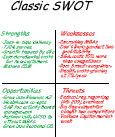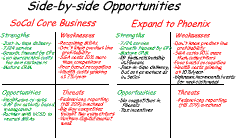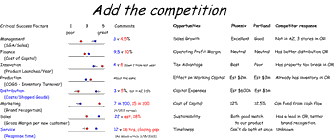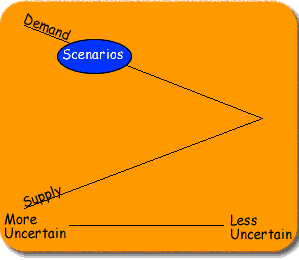|
SWOT Analysis
SWOT Variations:
Side by Side
CSF and Competitors
Decsion Matrix
Which SWOT analysis is best for you?
|
Key Points
The depth of analysis for each SWOT increases from the Classic SWOT
to a Decision Matrix.
I
recommended
that
you use the simplest approach that will help your team decide your
strategic focus and prioritize the work that needs to be done.
Techinques Advantages and Disadvantages
|
The four
methods proceed from least complex to most complex, both in time to prepare
and the research needed.


|
The Classic SWOT Analysis
 Pros Pros
- Easy to prepare for and construct
- Can compare multiple opportunities
- Assigns priorities when folks vote to identify the top five strengths, weaknesses, etc.
Cons
- Folks tend to focus on activities to be fixed inside the firm, rather than to benefits the customer
- Folks tend to be too generic about strengths and weaknesses, like "excellent management" or "poor communications."
- Overused, too often just a snap shot with no indication of the momentum, direction and history.
Side by Side SWOTs
 Pros Pros
- Comparing your best two or three opportunities helps you agree a strategic focus — "kill two birds with one stone"
- Timing and funding priorities become apparent
- Helps rehearse each opportunity as folks conceptualize what needs to be done
Cons
- Can be very tedious to compare five or more opportunities, too much detail
Comparing Critical Success Factors - You and Your Competitor
 This variation on the Classic SWOT compares the firm's performance to the competition or against an industry average for each of the industry's critical success factors and shows the history. Then, for the opportunities, it anticipates a competitors responses. The strategic planning team needs to anticipate the competitor's responses.
This variation on the Classic SWOT compares the firm's performance to the competition or against an industry average for each of the industry's critical success factors and shows the history. Then, for the opportunities, it anticipates a competitors responses. The strategic planning team needs to anticipate the competitor's responses.
Pros
- Easy to use quantitative performance measures to make comparisons
- Focuses on core competencies and your distinctive core competency, which helps measure the customer's perception of your value
- Educates a business unit or a large department about the firm's big picture
Cons
- Fewer specific details or issues are apparent — can be too generic, too status quo
- Innovations, solutions or strategic routes may not evolve from the analysis
- Does not provide a big picture of trends in you strategic or industry spaces
Decision Matrix for Complex, Costly Strategies
 The Decision Matrix takes detail from a SWOT and is used to determine an opportunity's (option, alternative, etc.) relative value compared to other opportunities. In the example, seven criteria are evaluated to compare two options and for each criteria, the options were scored as excellent (3), neutral (2) or poor (1). Supporting data can be included in a cell to amplify why it was scored. This technique allows the strategic planning team to integrate the SWOT with competitive inteligence, market trends. As a strategic planning facilitator, I use this frequently with experienced teams. The Decision Matrix takes detail from a SWOT and is used to determine an opportunity's (option, alternative, etc.) relative value compared to other opportunities. In the example, seven criteria are evaluated to compare two options and for each criteria, the options were scored as excellent (3), neutral (2) or poor (1). Supporting data can be included in a cell to amplify why it was scored. This technique allows the strategic planning team to integrate the SWOT with competitive inteligence, market trends. As a strategic planning facilitator, I use this frequently with experienced teams.
Pros
- A structured method to compare complex alternatives, a thoughtful coarse comparison
- In my experience, constructing the matrix educates and rehearses the team about the subtleties of each option, and
- Assigning weights educates the team about the senior leaders' perspectives
Cons
- The weights are subjective and will likely "draw fire" when presented to folks outside the core planning team
- The matrix implies quantifiable accuracy: to make it "scientific" is very expensive and time consuming
- Too many criteria (more than seven) dilutes the value of the weights. In the example, there are four items with a weight of 10%. Fewer criteria is better.
Which SWOT Analysis is Best for Your Team
 The goal of strategy formulation is to be clear and specific about the firm's strategic focus, or if you are part of an organization, your focus to support the strategy. Strategy specifics (called tactics) evolve as you develop action plans.
The goal of strategy formulation is to be clear and specific about the firm's strategic focus, or if you are part of an organization, your focus to support the strategy. Strategy specifics (called tactics) evolve as you develop action plans.
If you are developing scenarios, it is usually premature to develop a SWOT. Once the way is clear or you are down to two likely routes, that is the time to do a Side-by-side SWOT.
An Entrepreneur or a Bottom-Up effort in a firm would use a Classic SWOT or Side-by-side.
Within a firm, with a clear future and well established competitors, the team could use any of the variations. The considerations are:
- If many folks need to be involved, use the Classic SWOT — more detail will come to the team
- If there are several good opportunities, explore the specifics of how your strengths and weaknesses play out. Use the Side-by-side SWOT to get into the detail
- If you have a strong competitor in a high growth or mature industry, add the competitor to you assessments
- If you have very expensive, complex alternatives where you have a variety of techniques, use the decision matrix to identify the best alternatives, then apply judgment
 Decision Matrix Decision Matrix
|
|
Action Plans

|
|